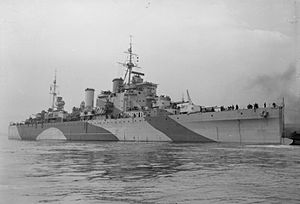This article includes a list of references, related reading, or external links, but its sources remain unclear because it lacks inline citations. (June 2008) |

| |
| History | |
|---|---|
| Name | HMS London |
| Namesake | London |
| Builder | Portsmouth Dockyard |
| Laid down | 23 February 1926 |
| Launched | 14 September 1927 |
| Commissioned | 31 January 1929 |
| Identification | Pennant number 69 |
| Fate | Sold for scrapping, 3 January 1950. Broken up from 22 January 1950 by T. W. Ward of Barrow |
| General characteristics | |
| Class and type | County-class heavy cruiser |
| Displacement |
|
| Length | 633 ft (193 m) |
| Beam | 66 ft (20 m) |
| Draught | 21 ft (6.4 m) |
| Propulsion |
|
| Speed | 32 knots (59.3 km/h) |
| Range | 9,120 nmi at 12 kn |
| Complement | 784 |
| Armament |
|
| Aircraft carried | One Supermarine Walrus, one catapult |
HMS London, pennant number C69, was a member of the second group of the County-class heavy cruisers of the Royal Navy. She and her sisters; Sussex, Shropshire, and Devonshire differed from the earlier group of Counties (known as the Kent class) by having a smaller forward superstructure, which was positioned slightly further aft, and little armour plating. HMS London's career spanned over twenty years.